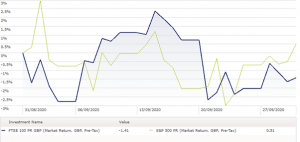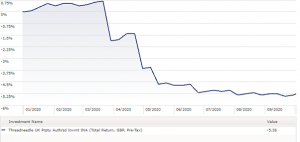Investment Report 4th October 2020
Most Markets have ended the month at a similar level to the start although the UK is down 1.4% on concerns over BREXIT.
The following chart shows the US and UK market during July. The FTSE 100 represents the 100 largest companies in the UK and the S&P 500 represents the 500 largest in the US. The Dow Jones is often quoted but this only shows the top 30 companies and is dominated by technology companies.

When there is nothing particularly exciting on the economic situation to report, I thought it might be interesting and hopefully reassuring, to explain why I have included a certain asset type or particular fund, in the Portfolios.
This month I wanted to focus on Property exposure within the Harmonic (growth) and Pentatonic (income) portfolios. This asset is not included in the Melodic (Socially Responsible Investment) portfolios as they are not considered ‘green’ enough.
Property funds were suspended from trading in March 2020 as a result of the independent valuers deploying the ‘market uncertainty’ clause over the accuracy of valuations in light of the potential economic damage caused by Covid-19. This has now been lifted and the Threadneedle UK Property fund is the first fund to lift the trading suspension. This fund is used for most of the Property exposure within client’s portfolios.
At times of economic uncertainty, some investors will want to sell their investments and when these are equity based (shares) it does not normally incur a delay as shares are traded daily. When it comes to property, it might mean a few properties need to be sold in order to meet withdrawals and as you know, property sales do not happen overnight.
If there are lots of withdrawals being made – or the value of the properties is being questioned – the fund manager is able to suspend trading in order to generate enough liquidity by selling a number of properties. The fund is then opened up to trading again and investors will be able to sell their holdings. During this period of suspended trading, if the economic outlook improves, there may not be so many people wanting to sell and this will then provide some stability to the price.
The price of Threadneedle’s has dropped approximately 5% for the year to date and you will see from the following chart that there has been no significant change in price since the fund started trading in mid-September.

I have yet to receive official confirmation, but it looks like the fund had withdrawals of approximately £100 million, representing about 10% of its value. As of September 1st, it was valued at over £945 million.
As of February, it had 14.8% held as cash so I will be interested to see how many properties it has sold in order to maintain liquidity. It does aim to keep as much as 20% in cash to support liquidity so will have sold properties to meet the withdrawals. With an average property value of £7 million I doubt it will have sold too many.
In February it had 1125 tenants in 136 properties. As of 1st August, the number of tenants has dropped to 1072. The largest tenants are Travis Perkins at 2.5%, Halfords at 2.3% Missouri Topco (Matalan) at 1.8%, Amazon at 1.5% and Dunelm at 1.4%.
Whilst this shows a bias towards retail shops the fund only has 16.6% exposure to shops – it is selective who it rents to.
The fund has 35.9% in Industrial properties such as storage facilities and the out of town warehouses with a trade counter.
It has 29% invested in Offices and 11.5% in Retail Warehouses such as The Range and Go Outdoors.
There is a full list of properties – as at the end of 2019 – available on request.
It has over 60% invested in the South of England, 15% in the North and 11% in the Midlands.
The reason this fund is used is because it has an excellent spread of properties that are targeting above average rental income. However, I expect the rental income for the period March to September will have been affected because a number of companies had to stop trading. I expect dividends to reduce for the next 6 months as a result.
My recent half-year investment report showed I wanted to adjust the exposure to property within your portfolio and I will be writing to confirm the recommendations shortly, with the exception of Offshore Bonds which are not allowing Property as an asset class at the moment due to tax complications.
This is a useful long-term asset to hold within portfolios in order to create asset diversification and whilst this fund has dropped by 5% for the year, the FTSE100 is still down by just under 20%.
All facts given for the Threadneedle fund are based on their fact sheet as of 31st July 2020 unless otherwise confirmed.
These comments are my own thoughts on the current outlook and in no way offer any guarantees.
As always, should you have any concerns you wish to raise, please do contact me.
We are Covid ‘safe’ and therefore able to see clients in the office now. However, video calls are proving very popular and we will continue to offer these as an alternative for the foreseeable future.

